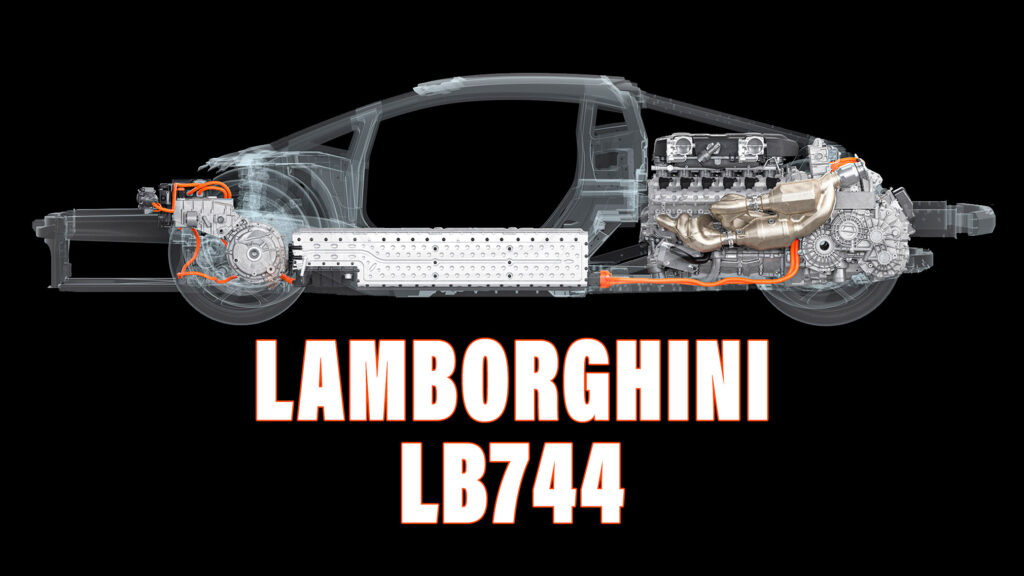As the world is patiently waiting for the big reveal of the next-generation Lamborghini flagship, the automaker announced the technical specifications of the electrified supercar which is codenamed LB744. The plug-in hybrid system comprises a new 6.5-liter V12, a new eight-speed dual-clutch gearbox, a lithium-ion battery, and a trio of electric motors, offering a combined output of 1,001 hp (747 kW / 1,015 PS).
Lamborghini detailed the underpinnings of its first “High Performance Electrified Vehicle” which will be unveiled soon as part of the celebrations for its 60th anniversary, replacing the discontinued Aventador and honoring the legacy of V12-powered supercars from Sant’Agata.
Read: Is This The 2024 Lamborghini Aventador V12 Successor?
The naturally-aspirated 6.5-liter V12 codenamed L545 has been “heavily reworked” with increased power output and lower weight compared to its predecessor. Changes include re-engineered air intake ducts, a new combustion system with an increased compression ratio, and improved fluid dynamics of the exhaust. As a result, the mill produces 814 hp (607 kW / 825 PS) at 9,250 rpm and 725 Nm (534.7 lb-ft) of torque at 6,750 rpm, making it the most powerful 12-cylinder engine to ever leave the Lamborghini factory. In fact, the ICE alone is 55 hp (41 kW / 55 PS) more powerful than the Lamborghini Aventador SVJ, while weighing 218 kg (480.6 pounds) which is 17 kg (37.5 pounds) less than the outgoing unit.
The combustion engine is still mid-mounted but it has been rotated by 180 degrees in the new layout. It works together with three oil-cooled axial flux electric motors – two at the front axle and one at the back positioned above the new eight-speed dual-clutch transmission. Thus, while the V12 channels its power to the rear wheels, the electric motors make it an all-wheel-drive supercar with sophisticated torque vectoring capabilities, and also drive all four wheels in the EV-only mode.
Each electric motor produces 148 hp (110 kW / 150 PS) and weighs 18.5 kg (40.8 pounds). Each of the front-mounted units contributes 350 Nm (258 lb-ft) of torque to the front axle, while the rear electric motor generates up to 150 Nm (110 lb-ft). The combined power output of the plug-in hybrid setup is an impressive 1,001 hp (747 kW / 1,015 PS), elevating the series-production flagship in the four-digit territory for the first time ever. Lamborghini didn’t announce the combined torque figure.

The 3.8 kWh lithium-ion battery pack is located within the transmission tunnel between the driver and the passenger, measuring 1,550 mm (61 inches) long, 301 mm (11.9 inches) high, and 240 mm (9.4 inches) wide. While charging takes 30 minutes from an external power source (7 kW), it can be completed in just six minutes from the V12 engine. As with all hybrids, the battery can also charge using energy from the regenerative braking system at the front wheels. Lamborghini didn’t reveal the EV-only range of the plug-in hybrid supercar but said that the overall CO2 emissions are reduced by 30% compared to the non-electrified Aventador Ultimae.
Another brand-new component is the eight-speed Double Clutch Transmission (DCT) mounted in a transverse rear position reminiscent of the 1966 Lamborghini Miura. It is rather compact, measuring 560 mm (22 inches) long, 750 mm (29.5 inches) wide, and 580 mm (22.8 inches) tall. More importantly, the in-house developed gearbox is lighter and faster than the seven-speed DCT found in the Huracan, while its placement allows for a roomier two-seater cabin compared to the Aventador. Furthermore, it has a “continuous downshifting” feature which drops down multiple gears by holding down the left paddle. Notably, there is no reverse gear in the DCT, with reversing taken care of by the trio of electric motors.
The new Lamborghini flagship will be unveiled “shortly” so keep an eye out for updates. We wouldn’t be surprised if the automaker continued the teaser campaign showing us more bits and pieces of the new model. In terms of the exterior design, we have already seen a fair bit on the allegedly leaked patent drawings, while the digital dash has been partly revealed in our recent scoop stories.

















